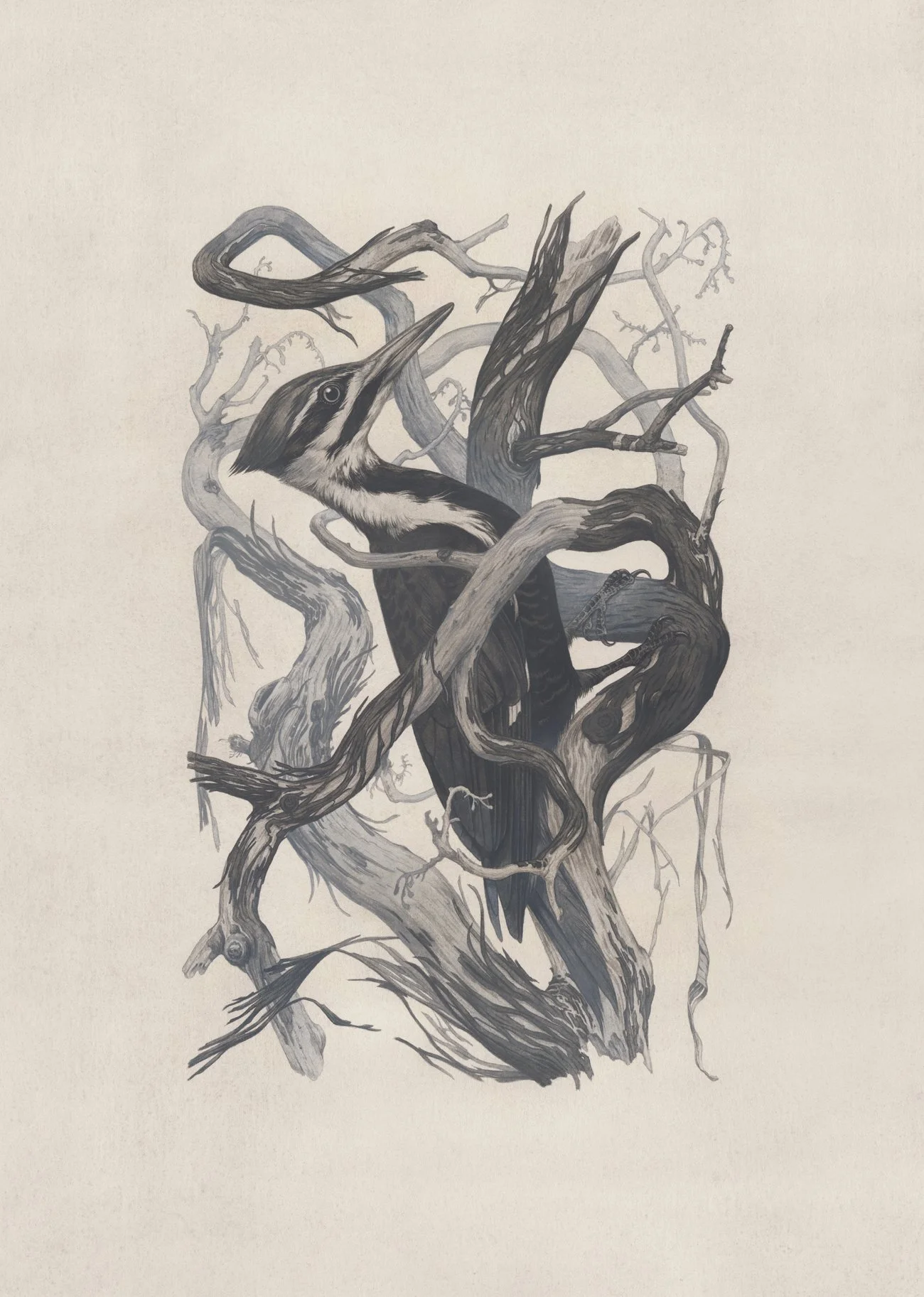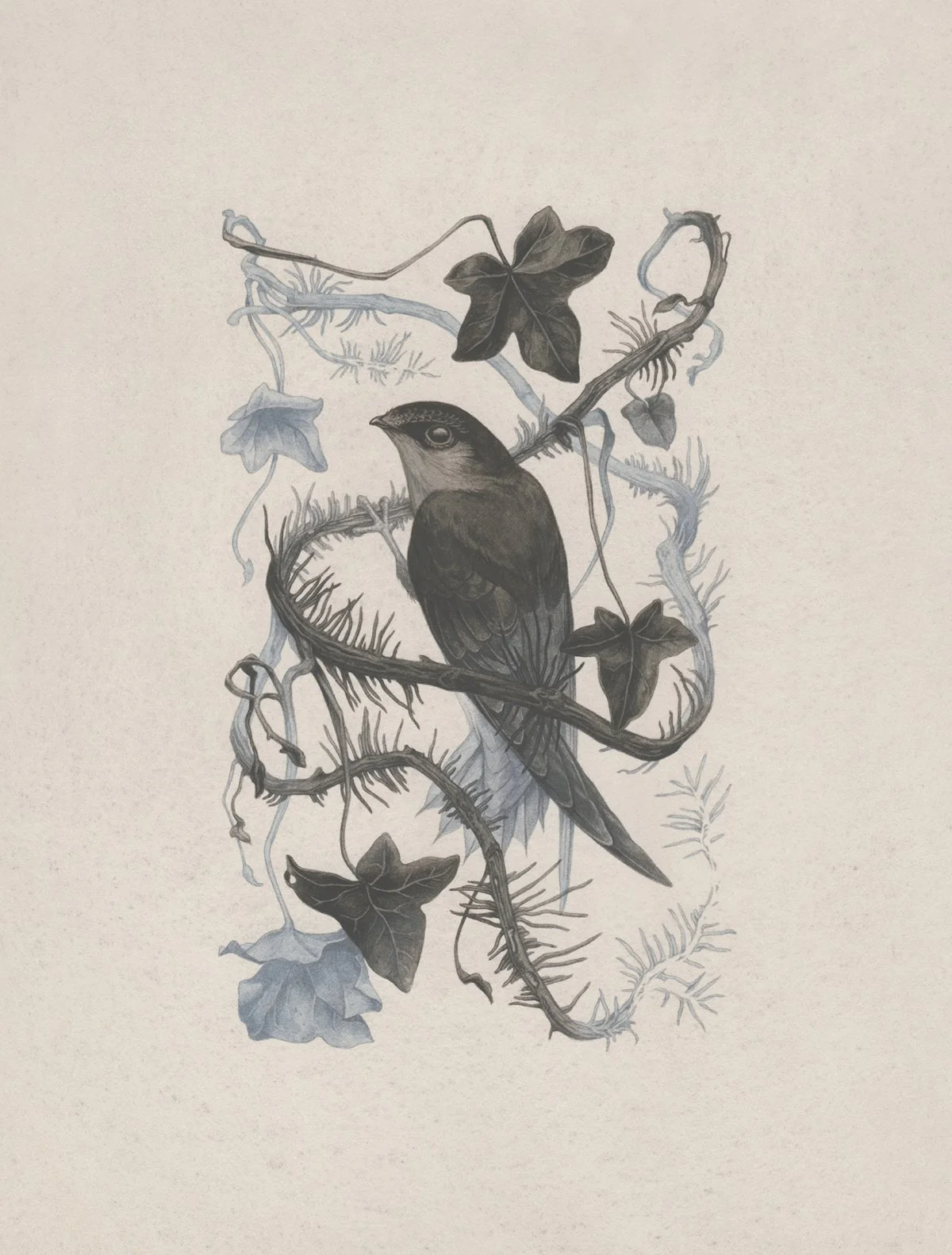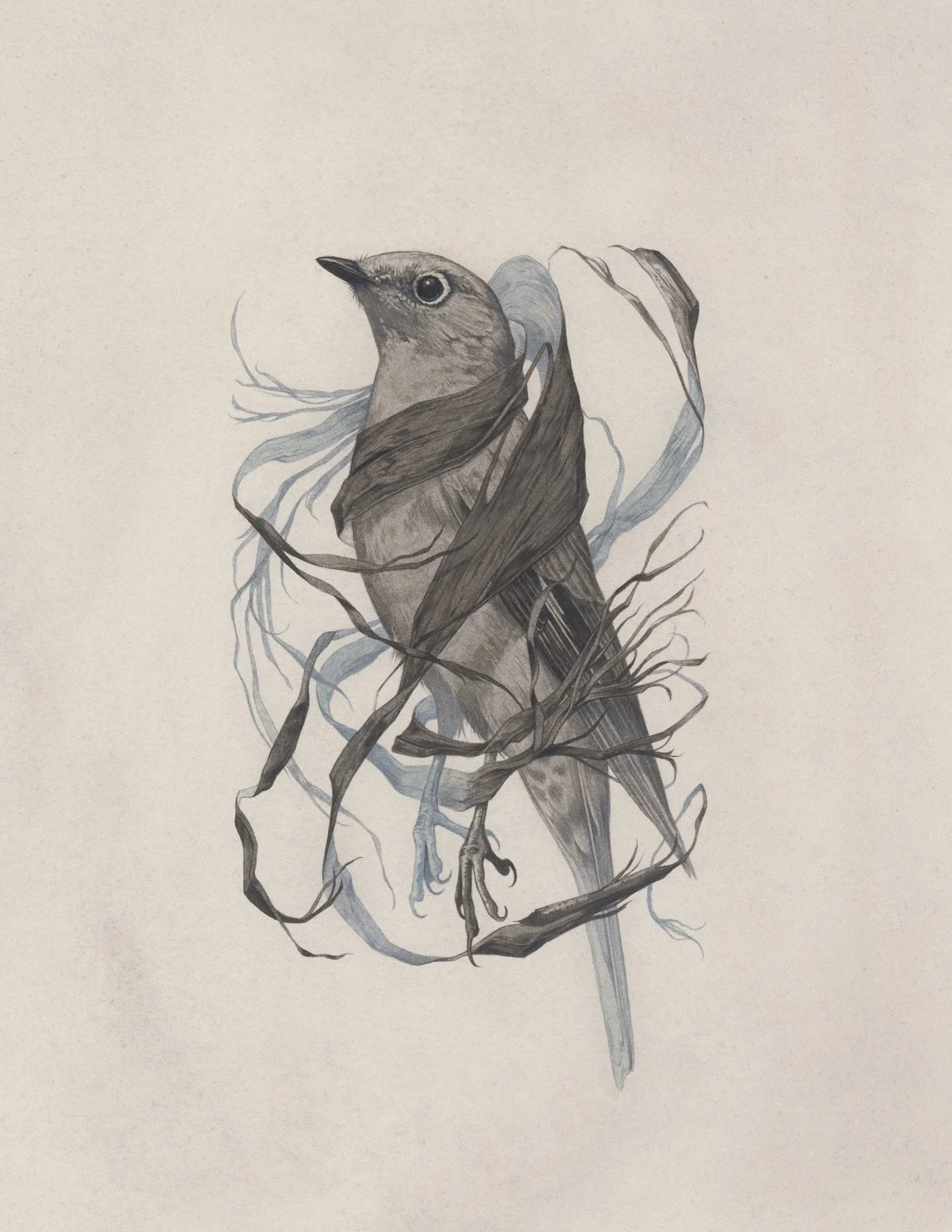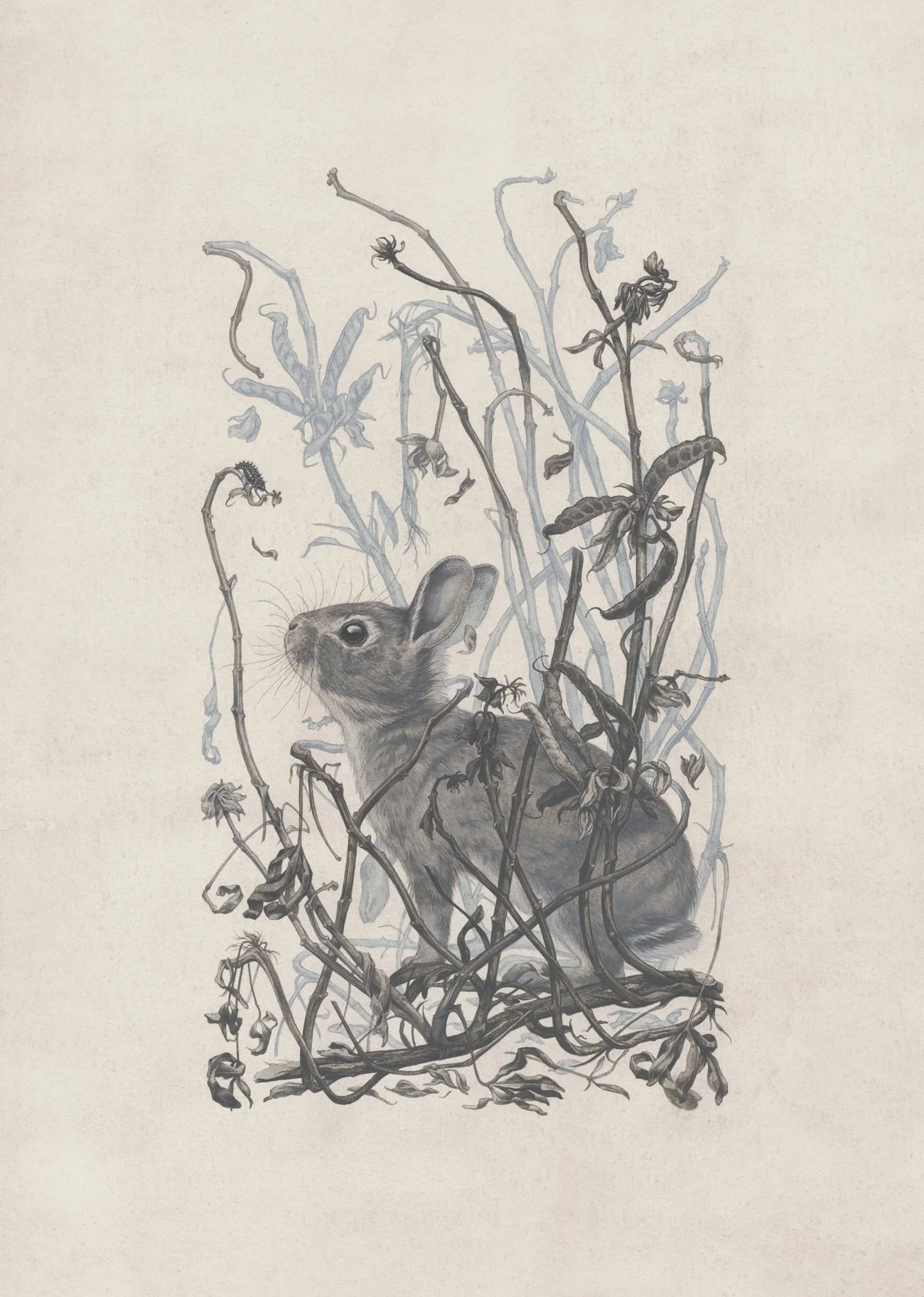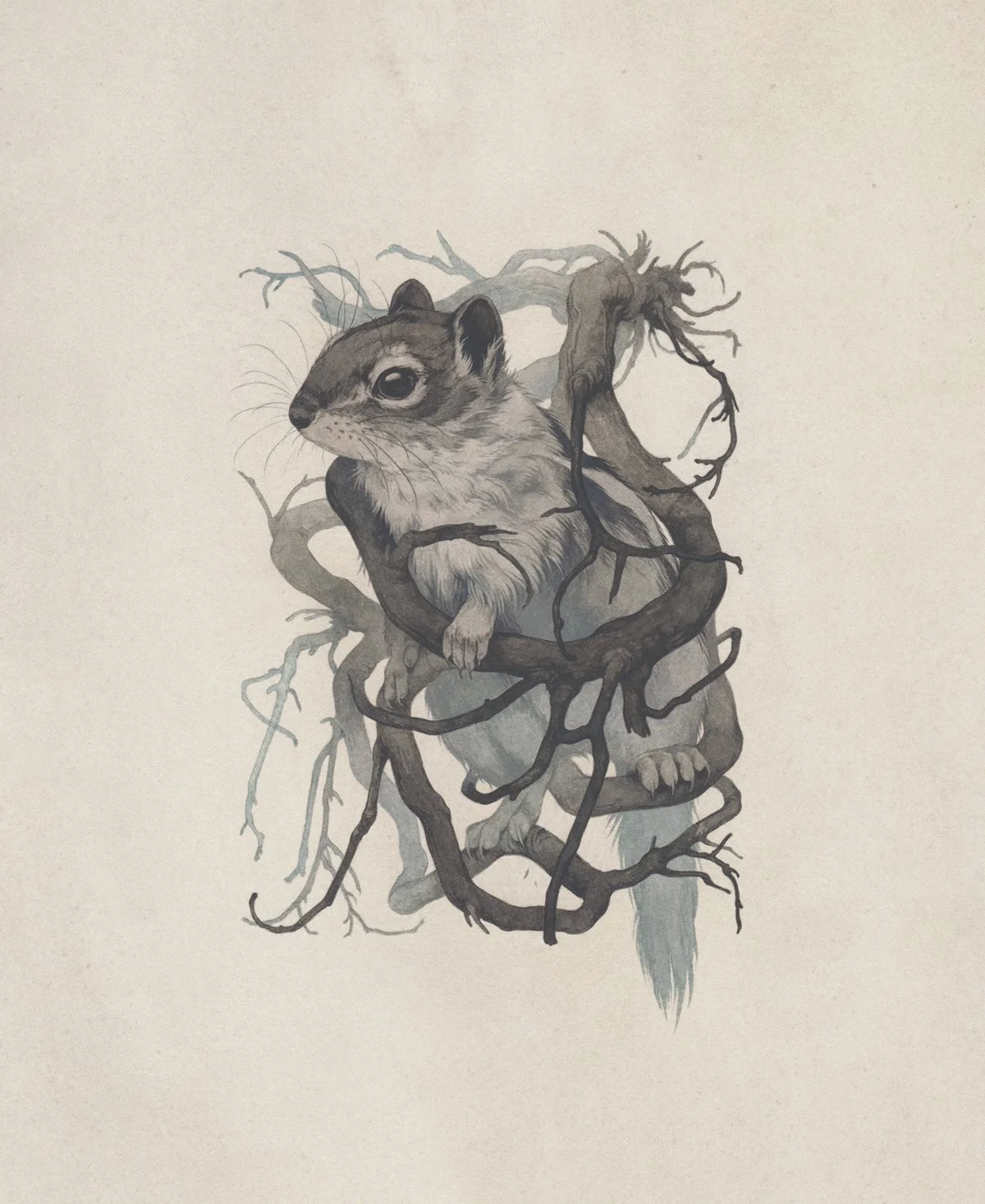Self-Immolator (Forgotten Gods) | 16" x 22" | gouache & watercolor on paper
the madrone trees i painted a few years back are dead now, their branches cut off and piled by the side of the trail. the bark that once curled and peeled in vibrant siennas and golds to reveal smooth trunks of olive and mahogany has been replaced by a coarse, brittle, coal-black web that splits open or falls away in thin ribbons to reveal bone-white branches. it’s one of the most beautiful forms of decay i’ve seen, and i drift from tree to tree, taking it in hungrily with my eyes and camera.
i haven’t been able to learn for sure what caused this transformation or the death of the trees — the most convincing explanation is some kind of fungal infection — and several helpful people offer suggestions for saving the trees by fighting the fungus. these trees are in a natural area, and i wonder where the line is between being stewards of the land, and curating it to our own preconceptions of beauty. is the goal of conservation to allow for self-determination, even if that means allowing a fungus to flourish in exchange for some trees? at what point in our interference does a wild place become a garden?
this park, situated on volcanic bluffs above the river, has been beautifully converted into an example of the mosaic of white oak woodland and prairie ecosystem that has been destroyed in so much of willamette valley, but its history is contested. local poet and environmental activist david hedges went to great lengths to singlehandedly prevent this land from being converted into a housing development in the 90s. in exchange for his trouble, the city logged the old growth douglas fir forest he fought hard to protect (and which predated european settlement), leaving the carpet of moss and ferns below to die, and converted the site to an oak savanna. (hedges also witnessed brush-clearing crews looting native american artifacts unearthed at the site.)
i’m unsure how to feel about this history. i’m grateful to have a place to see white oak trees covered in galls and woodpeckers and surrounded by camas and clarkia, where licorice ferns blanket the lava flows in winter and swaths of poison oak are allowed to hold their bright red hands up in a warning to stay on the path. i’m grateful for any chance, if fleeting, to see nature’s penchant for chaos to creep in and show me a phenomenon i may never see again, even at the cost of trees i loved dearly. but most of all i think i’m grateful for every old tree that goes unlogged, whether i’m around to see it or not.
Broken Grasp | 11" x 14" | gouache & watercolor on paper
across the river from a timber town, where the corpses of fir trees lie in orderly stacks awaiting export, there is a chimney in which thousands of vaux’s swifts roost each night of their fall migration. the dead old growth trees that swifts once roosted in have long since vanished, and suitable old chimneys are becoming scarce now too. for an hour the birds flit across the sky in quantities that make numbers meaningless, tiny against pastel clouds, at once like gnats and bats, but then unmistakably butterflies as they merge into a single organism, a dark and endlessly swirling cylinder that descends into the brick pillar and disappears with the sun.
Occupied Cavities | 11" x 14" | gouache & watercolor on paper
this year i’m fixated on dead ivy — a common sight in the pacific northwest, but far less common than the living plant, against whose spread the region is rapidly losing its war, despite the noble efforts of ecological gardeners and goats-for-hire. after an ivy plant is girdled to stop it from overtaking a tree, the vines above the cut die off, but their skeletons are left clinging to the bark for some time, and often become habitat for woodborers, who sculpt the woody branches in their calligraphy of tunnels and holes. a large woody piece of dead ivy sits on my desk for weeks as a painting reference, before a large woodborer larva crawls out to say hello. it’s valuable, i think, to find meaning in the death and disturbance around us, rather than looking away.
this week emerald ash borers arrived in portland, and we’ll soon lose many of the trees that shade our waterways, forests, and neighborhoods. as a devotee of the humble woodborer generally, it pains me to know that not only will these trees vanish, but most will be quickly or preemptively removed, their wood promptly hauled away to stop the spread, so most of us will never see the many messages the beetles carved into their still-living hosts. what would we begin to understand if we stopped and tried to read them? how would we learn to treat the land we live on, if we had to watch the slow deaths of the trees around us?
Exposed Canopy | 11" x 14" | gouache & watercolor on paper
the canyon below is impassable, filled with fallen trees from the eagle creek fire, but i waded through it once, the morning before the wildfire started. years later, the trail to the upper falls is newly reopened. the remaining trees stand tall and taciturn, some leafless, some barkless, some blackened and blistered. long ribbons of bast billow and twist overhead, stirred by the waterfall’s wind. a solitaire regards me from the naked bluffs; her call is piercing, a dying smoke alarm.
Self-Sower (Infested Nursery) | 16" x 22" | gouache & watercolor on paper
the baby bunny lives under a forest of lupines, children of last year’s single plant that has overtaken the wildflower patch. she ventures further day by day under the thrum of pollinator wings, as aphids multiply up the lupine stalks. clusters of papery flowers drop prematurely then fail to form at all, stems adorned instead in masses of grey-green insect bodies. in a heat wave the aphids vanish, leaving skeletal tendrils reaching up to an indifferent sun. bunny vanishes too, leaving her weightless white tail by the side of the road.
Evaporating Islands | 11" x 14" | gouache & watercolor on paper
rough skinned newts the color of decaying alder leaves and crumbling redcedar stumps dot the trail to the lake, and freeze when our footsteps approach. one journeys through a miniature landscape of wet moss and wood sorrel; another rolls over, and shows me a bright orange belly. countless more hang motionless in the warming shallows of the lake all around us, as the fallen logs we stand on release steam into the morning light of the winter sun.
Diluted Reservoirs | 11" x 14" | gouache & watercolor on paper
in the high desert, a golden-mantled ground squirrel poses very nicely for me on rocks that once stood at the edge of an expansive reservoir — now a shallow glimmer in the far distance. all around us, spidery limbs and roots of young junipers reach out, seeking the last traces of moisture, ushering in new worlds.
Caustic Nectar | 11" x 14" | gouache & watercolor on paper
i watched you fly backwards, drupes unfurled into buds
beaks exhaled worms, rain rose out of the mud
fall yielded to summer, hewed logs sprang up as trees
you unbound our blunders, i crawled into the sea
Aimless Path | 9.5" x 9.5" | gouache & watercolor on paper
Fleeting Artifacts | 11" x 14" | gouache & watercolor on paper
false refuge
nucleus portland
september 2025
In my series False Refuge, the work is led by my fascination with certain plants in states of deterioration: lupines in my garden infested with aphids, dead ivy carved with a maze of barkborer tunnels, strands of inner tree bark left exposed after a wildfire. These materials weave around each piece's animal inhabitant, locking them into their would-be habitat in a way that's more evocative of cage than landscape. Each piece is surrounded by excess negative space to heighten the contradiction between the potential for us to create and preserve safe haven for fellow creatures, and the inadequacy of the shrinking and weakened lands they are left to navigate.
Two pieces from the series, Diluted Reservoirs and Evaporating Islands, were previously created for the 2023 group show “Sanctuary” at Mortal Machine Gallery in New Orleans. False Refuge is an ongoing series.


